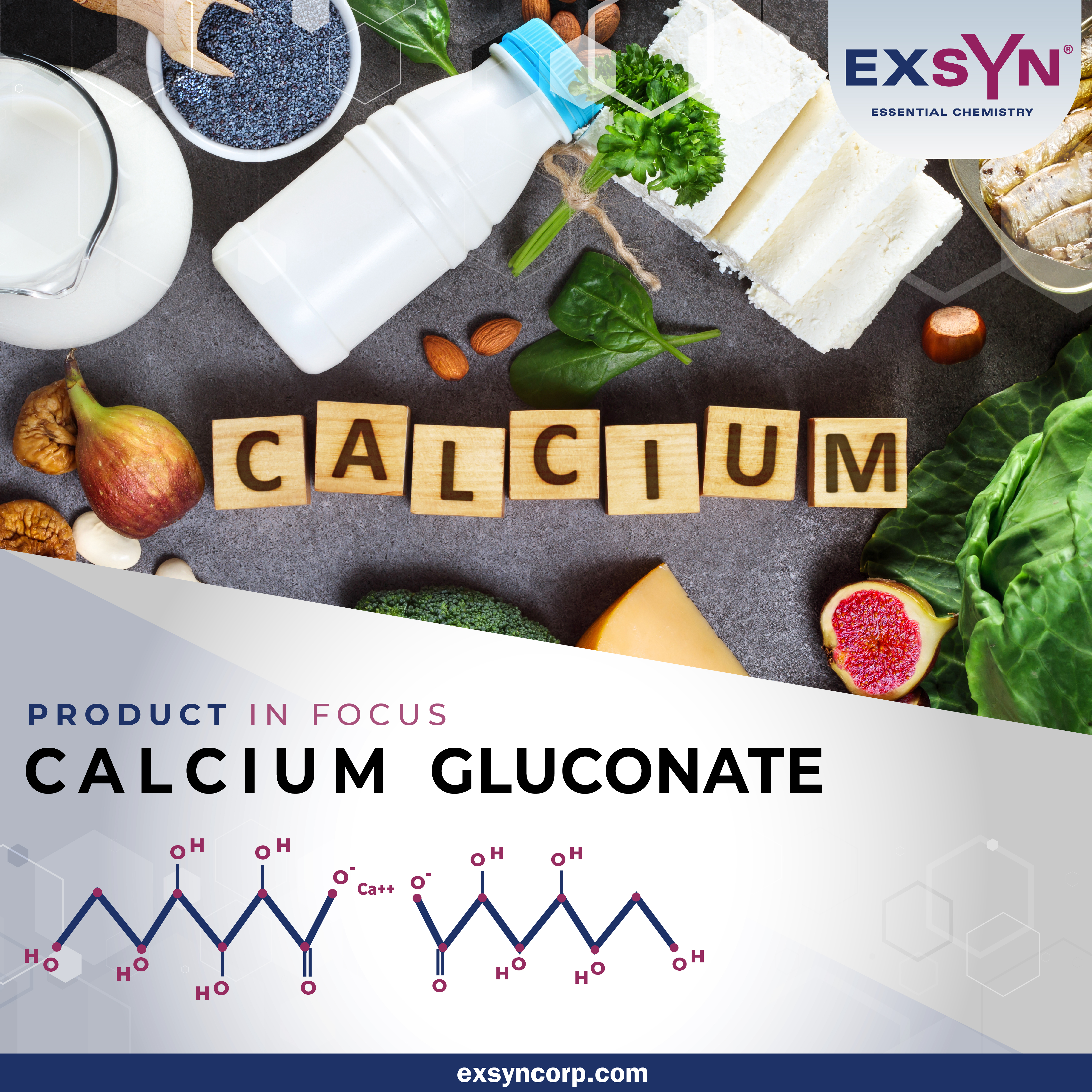INTRODUCTION
Calcium Gluconate is the calcium salt of gluconic acid, an oxidation product of glucose, and contains 9.3% calcium, which is about one-third of the calcium in the strength of calcium chloride. It is an ingredient found in a variety of supplements and vitamins and is used to lower potassium in the blood. Calcium gluconate is used as a mineral supplement and medication when there is insufficient calcium in the diet. Supplementation may be done to treat or prevent osteoporosis or rickets, consequences of hypocalcemia.
Manufacture
It is made by mixing gluconic acid with calcium carbonate or calcium hydroxide
| Synonyms | Calcium di-(D-gluconate) D-Gluconic acid calcium salt |
| CAS no. | 299-28-5 |
| EINECS no. | 206-075-8 |
| Molecular formula | C12H22CaO14 |
| Molecular weight | 430.37 |
| Structure |
Applications
| Calcium gluconate is used to prevent or treat calcium deficiencies. Oral calcium salts are used as dietary supplemental therapy for people who may not get enough calcium in their regular diet |
| Calcium gluconate is used as a cardioprotective agent in high blood potassium |
| Calcium gluconate is the antidote for magnesium sulfate toxicity |
Calcium gluconate is also used as/for:
| Hyperkalemia |
| Hypocalcemia tetany |
| Dietary Supplement |
| Hungry Bone Syndrome |
| Tumor Lysis Syndrome |
SPECIFICATIONS – for injection, EP
| Test | Unit | Specification |
|---|---|---|
| Appearance | – | White or almost white, crystalline or granular powder |
| Solubility | – | Sparingly soluble in water, freely soluble in boiling water |
| Identification A. TLC B. Reaction of Calcium | – – | Shall pass the test Shall pass the test |
| Appearance of solution | – | At 60°C, solution S is not more intensely colored than reference solution B7. After cooling to 20°C, it is not more opalescent than reference suspension II. |
| pH | – | Between 6.4 and 8.3 |
| Organic impurities & Boric acid | – | Shall pass the test |
| Oxalates | ppm | Max 100 |
| Sucrose & reducing sugars | – | No red precipitate is formed |
| Chlorides | ppm | Max 50 |
| Phosphates | ppm | Max 100 |
| Sulphates | ppm | Max 50 |
| Iron | ppm | Max 5 |
| Magnesium & alkali metals | % | Max 0.4 |
| Assay as C12H22CaO14H2O | % | Between 99.0 and 101.0 |
| Microbial Contamination | ||
| Bacterial endotoxins | IU/g | Max 167 |
| Total aerobic microbial count | CFU/g | Max 10(square) |
STORAGE
Store in a cool & dry place. Keep away from moisture.
PACKING
25 kg drum.
REGISTRATION / CERTIFICATION
US-DMF, CEP, EU-GMP, EU-WC (Written Confirmation)
No matter the quantity you need, our exceptional quality and service will make ExSyn your supplier of choice! If you need any additional information or SDS, please contact us.
Iodine is anon-metallic, dark-grey/purple-black, lustrous, solid element. It is the heaviest and the rarest of stable halogens that can be found on the crust of earth.About fifty percent of all iodine produced and manufactured worldwide is used to form Organoiodine compounds. Iodine is an important element for many health-sustaining processes and essential for human thyroid health.
The product, acronymed Oct-NBE, is an organic compound with a cyclic ring system and a 8-membered hydrophobic chain. The structure renders the chemical special properties leading to its applications in diverse fields.
Nicotine is a hygroscopic, colorless to slight yellow, oily liquid, that is readily soluble in alcohol, ether or light petroleum. It is widely used recreationally as a stimulant and anxiolytic.
The product, acronymed ETD, is an organic compound with a fused bicyclic ring system and an ethylidene group. The structure renders the chemical special properties leading to its applications in diverse fields.
Sodium perchlorate monohydrate is the inorganic compound with the chemical formula NaClO4•H2O. It is the common existence form of sodium perchlorate, which can gradually absorb water in the air to form the monohydrate. Sodium perchlorate monohydrate is white rhombic crystal which is highly soluble in water and in alcohol. Its capacity to undergo redox reactions, liberating oxygen atoms, has been harnessed in the preparation of specialty chemicals, including pharmaceutical intermediates and fine chemicals.
Triphenylphosphine is a common organophosphorus compound that is frequently abbreviated as PPh3 or Ph3P. It is widely used in organic and organometallic compound synthesis because it is an effective reducing agent as well as a neutral ligand. At room temperature, PPh3 crystals are relatively air-stable and colourless.
Potassium chlorate holds significant importance across various industries due to its diverse applications. This white crystalline compound has been utilized for centuries as an essential ingredient in the production of matches, fireworks, and explosives, owing to its ability to release oxygen upon decomposition.
Podophyllotoxin is a non-alkaloid toxin lignan extracted from the roots and rhizomes of Podophyllum species. It is an organic heterotetracyclic compound that has a Furonaphthodioxole skeleton bearing a 3,4,5-trimethoxyphenyl substituent.
Octadecylphosphonic acid (ODPA), a versatile chemical compound, serves as a surfactant and dispersant in applications spanning coatings, lubricants, and corrosion inhibition. With its hydrophobic octadecyl chain linked to a phosphonic acid group, it excels in surface modification, boosting adhesion in metal surfaces.
